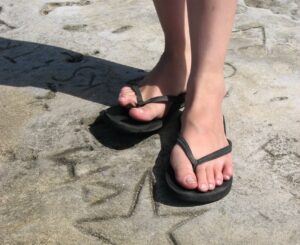So spring is here and you have decided you want to get out and start running. Just make sure you have the right tools for the job… specifically your sneakers! Here are 10 tips for choosing running shoes to keep you healthy, comfortable, and safe while training:
Shoes Don’t Multitask. Walking shoes differ from running shoes. Walking shoes are stiffer, while running shoes are more flexible, with added cushioning to handle greater impact. If you perform both activities, buy a pair of sneakers for both.
10 Tips for Choosing Running Shoes- “Wet Test”
Know Thy Foot- Perform the “Wet Test”. No foot is created equal. Even your own feet can be different from one another. Before choosing your running shoes, you should know your feet!
The best way to determine your foot’s shape is to perform a “Wet Test.” Wet your foot, step on a piece of brown paper, and then trace your footprint. If your footprint shows the entire sole of your foot with little to no curve on the inside — or if your shoes show the most wear on the inside edge — it means you’ve got low arches or flat feet and tend toward overpronation — meaning your feet roll inward. Overpronation can create extra wear on the outside heel and inside forefoot. You’ll want a shoe with a motion-control feature and maximum support. If the footprint shows only a portion of your forefoot and heel with a narrow connection between the two — or if your shoes wear out mostly on the outside edge — you have high arches and tend to underpronate (also called supinate), meaning your feet roll outward. Underpronation causes wear on the outer edge of the heel and the little toe. Look for a cushioned shoe with a soft midsole. You have a neutral arch if your footprint has a distinct curve along the inside and your shoes wear out uniformly. Look for a “stability” shoe, which has the right mix of cushioning and support.
Measure Your Foot Often. “It’s a myth that foot size doesn’t change in adults,” says Steven Raiken, MD. “It does change as we get older, so have your feet measured twice a year. Sizes also vary between brands, so go by what fits, not by what size the shoe is.” Raiken is director of the foot and ankle service at the Rothman Institute at Thomas Jefferson University Hospital in Philadelphia. Measure your feet before choosing your running shoes!
Sneaker Shop Toward the End of the Day. Feet swell over the course of the day; they also expand while you run or walk, so shoes should fit your feet when they’re at their largest.
Bring Socks. Make sure you bring the type of socks you wear while running or walking when you are choosing your running shoes. If you wear orthotics, bring those, too. Shoes need to fit with the orthotic inside.
“Breaking in” is a Myth. Running and walking shoes should feel comfortable right away. Don’t be embarrassed to walk or run around the store a bit to make sure they feel good in action!
Shop at eBay.com and Enjoy Up To 10% OFF On Select Items With eBay Coupon Extras. Save on health, beauty, toys and more! Click here
The Rule of Thumb. There should be about 3/8-1/2 inch between the front of your big toe and the end of the shoe (about a thumb’s width). The heel of the shoe should fit relatively tightly and should not slip out when you walk. The upper part of the shoe — which goes over the top of your foot — should be snug and secure, and not too tight anywhere. The American Academy of Orthopaedic Surgeons writes that while wearing an athletic shoe you should be able to freely wiggle all of your toes when the shoe is on.
Understand the Lingo and the Tech. Some models of running shoes look bizarre or exotic, but some of those wacky features actually serve a purpose. Clear inserts, filled with gel, Freon, or air, provide extra shock absorption, as do those springy-looking things. These features are especially helpful for those walkers and runners who experience heel pain. These same shoes, however, are not suited for people whose ankles twist easily…shoes with extra cushioning tend to provide less traction.
Don’t over- or underpay. Good quality running and walking shoes are fairly expensive- you get what you pay for. When choosing running shoes don’t pay $20 on a pair of shoes and believe they will outperform the $80 pair. Keep in mind that you can be swindled by advertising. Don’t be fooled in wearing the “celebrity favorite” sneaker for the highest price- most likely they won’t be any better for your feet.
Know When to Replace Them. The average pair of running shoes should be replaced after about 350-400 miles of use. You can also let your senses be your guide- asses the shoes on how they look and feel. Once the back of the sole is worn out or the shoe feels uncomfortable or less supportive, it’s time to toss that pair and get yourself some new ones!















